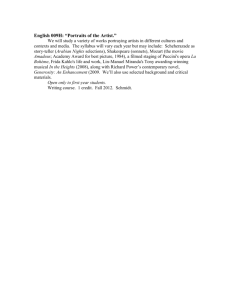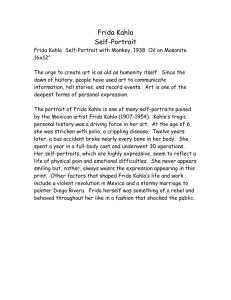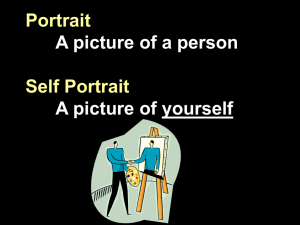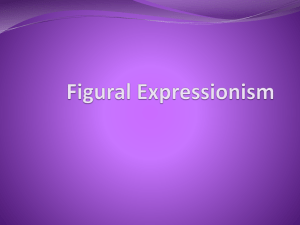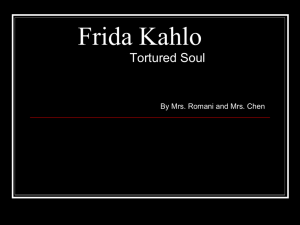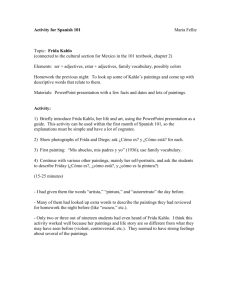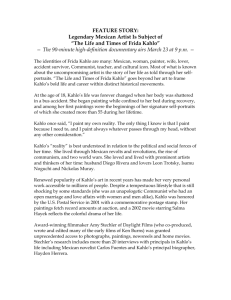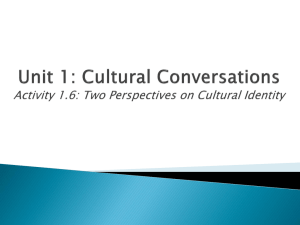File - Audrey Dumadag's ePortfolio
advertisement
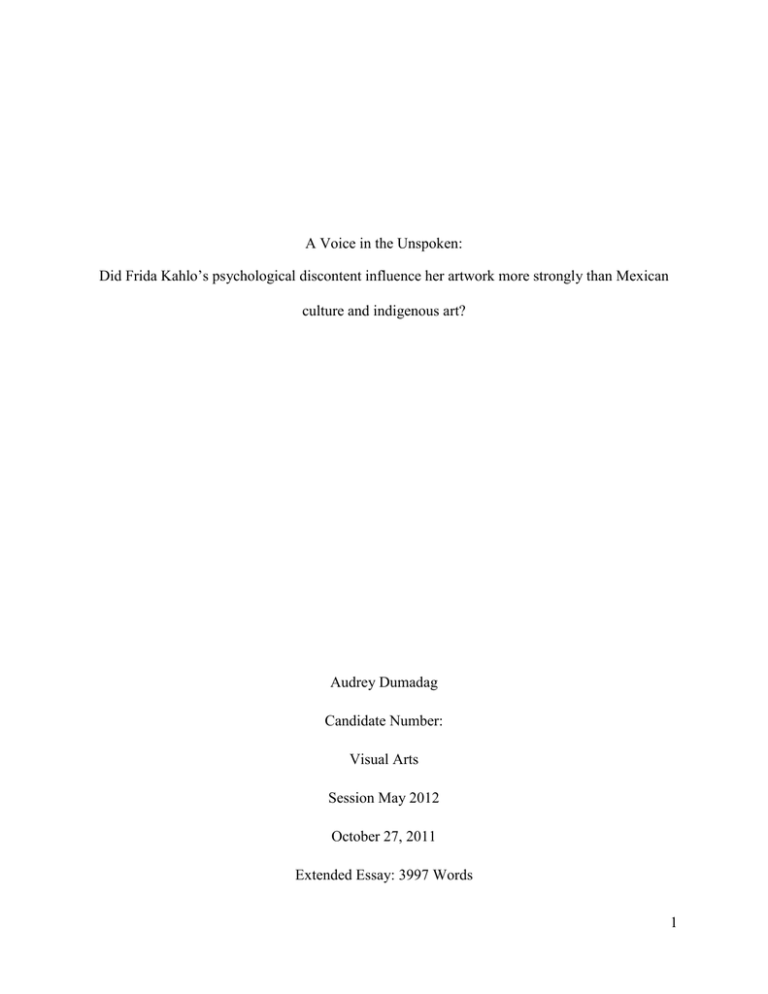
A Voice in the Unspoken: Did Frida Kahlo’s psychological discontent influence her artwork more strongly than Mexican culture and indigenous art? Audrey Dumadag Candidate Number: Visual Arts Session May 2012 October 27, 2011 Extended Essay: 3997 Words 1 Abstract: 299 Words Abstract This investigation centers on the extent to which Frida Kahlo’s psychological distress influenced her artwork more strongly than Mexican indigenous art and culture. Its purpose is to scrutinize the development of her style, and to evaluate the weight of her psyche over powerful cultural influences. It explores how the artist incorporated features of indigenous art into her own oeuvre. Throughout her life, the effect of her psyche as an overarching topic dominates. She first used European portraiture influences; however, she began to integrate indigenous art as she progressed as an artist (Lowe 761; “Kahlo (y Calderón)” 721). This incorporation became a recurring motif in her art. Even against the Mexicanidad, Kahlo remained unwavering in her fidelity to portray psychological conflict. In comparison to indigenous art and Kahlo’s contemporaries such as Diego Rivera, her use of culture did not instill patriotism. Her artwork was not the same as that of her contemporaries and Aztecs because she did not portray Mexico’s culture. The assimilation of indigenous deities did not overpower the true psychological meanings within her work. Even as her precise style fluctuated, she continued to paint, and her distressed condition only showcased this discontent even more (The Still Lifes 108). Her cultural context and art are not reflective of each other, but instead provide insight into her inclusion of such ideas. Her intentions were to create windows into her internal conditions, and her subject matter was not that of Mexico, but rather, her tormented self. She appropriated Mexican art and indigenous culture to serve as a vehicle to portray her psychological conflict. Moreover, the interplay of Mexican and European influences created her conflicted duality motif. The effect of Kahlo’s psychological struggle on her artwork confirms its weight against her cultural impact, exhibited by the human suffering in her fantastic compositions. 2 Table of Contents I. Introduction………………………………………………………………………............. 1 II. The Effect of a Traumatic Bus Accident on her Psyche……………………………….. 2-4 III. Her Marriage to Diego Rivera and its Psychological Effects…………………………...5-7 IV. Mexicanidad…………………………………………………………………….................8 V. The Progression of her Self-Portraits………………………………………………….9-12 VI. Still Lifes as a Method of Displaying her Emotional and Mental Feelings………….13-14 VII. Psychological Effect on Style………………………………………………………..14-16 VIII. Conclusion……………………………………………………………………………16-17 IX. Bibliograpy…………………………………………………………………………...18-19 X. Appendix……………………………………………………………………………..20-21 3 Introduction Since the mere beginnings of her life, Frida Kahlo always aimed at defying societal norms and embracing herself as a person. Although she was born in 1907, she chose to associate “her birth with the year 1910” (Kettenmann 7; B. Levine 70). This significant year marked the beginning of the Mexican Revolution as well as the beginnings of a conflicted, rebellious woman. It also showcases her fidelity toward her culture (20th Century: America 1092). In a sense, Kahlo’s life was her own mental revolt against popular culture. She suffered from polio and separation anxiety, but would challenge her limitations through her personal rebellion (The Still Lifes 11). Once, she even dressed in male attire for a family portrait to make a statement about a person’s role in society (Kettenmann 11). Nevertheless, Kahlo’s psyche suffered torment from a young age, and her artwork reflected this deviation from the societal norm. She was never afraid to create art that was widely different from her contemporaries, and, more importantly, extremely unorthodox for a woman. As a well-known Mexican artist, critics around the world compare her art as it relates to the traditional art of her native country and contemporaries. It is interesting to investigate how her cultural context and the influence of her heritage inspired her artwork. However, in understanding Kahlo’s art, peering into the psychological abyss of her conflicted reality creates a more accurate representation of what the artist wishes to convey. Using art as her creative solace, she portrays the mind battle that stems from the interplay of her psychological discontent and the world in which she lived. Although her cultural milieu did affect her art, Kahlo’s psychological discontent significantly impacted her work as evident by her surrealistic portrayal of identity, relationships, political dogmas and internal pain. 4 The Effect of a Traumatic Bus Accident on her Psyche At the young age of eighteen, Kahlo suffered from a horrific bus accident in her native town, Coyoacán (20th Century: America 1092). She experienced great pain from the penetration of a pole into her body, which would complicate her dreams to become a mother. During the period of her recovery and solitude, Kahlo became a selftaught painter (A Dictionary of 20th Century Art 308). Fig.1 Self-Portrait Wearing a Velvet Dress, 1926 She created a series of paintings that would ultimately change as her style developed. 31 x 23.5 inches Frida Kahlo Private Collection Painted in 1926, Self-Portrait Wearing a Velvet Dress (Fig. 1) is one of her first pieces created during this http://www.artworkonly.com/artreproductions/c olour-scheme/yellow/self-portrait-wearing-avelvet-dress-1926.html recuperation. Unlike most of the artwork she created, this painting mirrors portraits of the Italian Renaissance (Lowe 761; “Kahlo (y Calderón)” 721). She follows the three-quarter profile view indicative of art in the European Renaissance. Bronzino, a Mannerist painter, was a significant influence in developing her work (Lowe 761). She too rendered her pieces with the precision and realism of Mannerists. Her specific inspiration is Bronzino’s 1540 painting, A Young Woman with her Little Boy (Udall 10). She adopts the profile view and the rich color of the young woman’s extravagant gown (see Appendix, Fig.13). Also, the hand placement and the paleness of her figure against the dark background is reminiscent of his 1551 Portrait of Maria de' Medici (Fig. 14). The background behind the figure lacks spatial depth as most Renaissance paintings do. Contrary to later self-portraits, she does not emphasize this depth or her facial hair, and wears the rich velvet wardrobes of the wealthy (Lowe 761). Her 5 robe implies European wealth rather than Mexican aristocracy. Unlike the majority of her works, there is no indication of the influence of Mexican culture or pre-Columbian art. Therefore, even since the beginning of her career, she intended that her works reveal insight into her psyche rather than her culture. As a budding artist, she aimed to improve and polish her artistic abilities before embarking on a journey to discover her artistic purpose. The rendering of flat figures demonstrates the development of her style. Even if her figures are unbending in contour, her style is reflective of her artwork to come (Kettenmann 15). Also significant in this painting is Kahlo’s depiction of solitude. Against the dark, gloomy background, she stands alone in her sadness (Herrera 721). This theme of solitude is a motif throughout Kahlo’s work. As she progressed as an artist, her style, once similar to 19th-Century portraiture, evolved into her personal story. Art served as a catharsis for the anger and suffering from the unfortunate events in her life (Garber 46; Cotter 1). With art as her creative outlet, Kahlo discovered she could utilize this craft to portray the duality of her conflicting torment, and to “confront, communicate, and exorcise pain [that] became a motivating force in her art” (“Beauty to his Beast” 120). The results of the accident caused her to face the limitations of her life and proximity of death. This suffering Fig 2: Self-Portrait “Time Flies,” 1929 brought about an obsession with death, a recurring idea in her 30.5 x 24 inches work (The Still Lifes 11). As evident in Self-Portrait “Time Frida Kahlo Flies” (Fig. 2), Kahlo integrates pre-Columbian jewelry to Private Collection of Anthony Bryan http://www.fridakahlofans.com/c0040.ht ml 6 further emphasize the transience of time and the inescapability of death (The Still Lifes 16). She also uses the airplane and clock as the foundation of the piece’s contemporary setting (Udall 11). In contrast to her first self-portrait, the artist rejects the influence of European art. She directs her pose to a frontal view, and emphasizes the figure stylistically to convey realism of humanity’s blemishes (Kettenmann 22). Significant is her exploitation of the unibrow as a signature mark of her identity. Additionally, this painting depicts a degree of depth, a feature absent in Self-Portrait “Time Flies,” in that there is spatial recession. The beginnings of her application of bright colors also start surface as she lightens her hues from the dark richness of her previous work. These colors hold significance in that she defines each to represent a shade of her sentiments (Kahlo 211). In addition to colors, Kahlo incorporates Mexican culture to further demonstrate her mental conflicts. The use of pre-Columbian artifacts adds meaning to the briefness of life (The Still Lifes 16). The Aztec glyph suggests the journey of life and the start of her affiliation with Rivera (Udall 11). The intersected marks on her necklace represent death and illuminate the dark connotations within the work (The Still Lifes 16). Together, they provide insight into her psychological response to death and realization of life’s insignificance on the grand scale of time itself. The cultural impact of Kahlo’s Mexican heritage suggests that her life laid the foundation of her work; however, her psychological response to these events is what really brings meaning and depth into her art (Helland 12). The juxtaposition of beginnings and ends imply the beginnings of mental conflict. This influence of Mexican art and culture only grew stronger through her emotionally noteworthy relationship with Mexican muralist, Diego Rivera. 7 Her Marriage to Diego Rivera and its Psychological Effects To establish herself as an artist, Kahlo asked Diego Rivera to critique her work and evaluate the extent of her abilities (Frida). Both artists influenced one another throughout their relationship (M. Levine 271). Together, they became highly involved with Communism and altered their ways to assimilate this political ideal (Kingsolver 211). Painted in 1933, My Dress Hangs There (Fig. 3) is Kahlo’s response to “Gringolandia,” also known as the United States. When visiting the United States, she criticized high society’s luxurious way of life (“Beauty to his Beast” 126). She expresses her disapproval by juxtaposing collage and paint (Baddeley 15). The focal point of this piece is the Mexican peasant dress that hangs lightly on a clothing line (Helland 10). The bright garment contrasts with the industrial setting as it hangs in tranquility as an objection to Capitalism. Incorporating this dress is not only to express her Mexican nationalism and Communist tendencies; it presents the duality in confronting her inner beliefs in Fig 3: My Dress Hangs There, 1933 contrast to that of Rivera. 18 x 19.75 inches Frida Kahlo She highlights the subjugation of Capitalism through her chaotic collage and Hoover Gallery http://www.arthistoryarchive.com/arthistory/surrealism/imag es/FridaKahlo-My-Dress-Hangs-There-1933.jpg busy composition; moreover, she comments 8 on female constraints by overpowering the dress, billboard, and the Statue of Liberty with industrial surroundings (Helland 126). By doing so, she comments on the superficiality of America during this period. She exhibits fidelity toward Mexico against the increasingly popular commercialism (Baddeley 16). Her work almost mirrors the murals (Fig. 15) of Mexican Muralists such as Diego Rivera. While Rivera influenced her work, Kahlo did not create large murals that showcased Mexico’s history, but rather small visuals into her mind (Mencimer n.p.). Their artistic and ideological disparity resulted in distrusting turmoil which only intensified her tormented psyche. The mental toll of Rivera on the already fragile Kahlo impacted her artwork the most. After his affair with her sister Cristina, she plummeted into a deep state of mental distress (“Frida Kahlo’s Memory” 3). She developed a strong attachment for Rivera that haunted her psyche after their separation (B. Levine 242). Memory (Fig. 4), painted in 1937, is a depiction of Kahlo’s interminable struggle with Rivera. In this painting, Kahlo expresses a transformation and its effect on her mind. She successfully emits her powerful emotions through her bleeding heart, indicative of Mexican retablos (Fig. 16), and the piercing Fig 4: Memory (The Heart), 1937 15.75 x 11 inches bow through her chest and Tehuana dress (20th Century: Frida Kahlo America 1097; Lowe 761). Moreover, the portrait displays a Private Collection spatial recession in that the old, European Frida recesses to the http://www.arthistoryarchive.com/ar thistory/surrealism/images/FridaKah lo-Memory-1937.jpg background to allow the new, prideful Mexican Frida to surface the foreground. Ambivalent in her feelings, Kahlo firmly plants 9 one foot, while the other acts as a sailboat (“Frida Kahlo's 'Memory'” 3). This suggests her decision to follow Rivera, symbolized as the ocean, and to undergo the capricious current of his love (“Frida Kahlo's 'Memory'” 4). She expresses her distress by presenting her emotional division; Kahlo grieves at her husband’s unforgivable actions, yet is unable to relinquish her love. She was able to release her sadness and aggression through Tunas, Still-Life with Prickly Pears (Fig. 5), a depiction of disconcert in her relationship. Into this piece, Kahlo pours out her anger by selecting vibrant reds to support her theme. In Mexican culture, prickly pears symbolize the pierced hearts of sacrificed victims. It appears Fig 5: Tunas, Still-Life with Prickly Pears, 1937 as if the damaged pear in Kahlo’s piece enlivens 8 x 9.5 inches and bleeds; this pear represents Rivera’s heart. She Frida Kahlo mourns Rivera’s untrustworthy actions and attempts to seek revenge through art (The Still Lifes Private Collection http://www.frida-kahlo-foundation.org/thecomplete-works-2-48-3-0.html 4). Kahlo utilizes the common Mexican fruit to subtly showcase a corrupt and distrusting relationship. The fruit also alludes to the Aztec goddess, Coatlicue (Fig. 17), who wore a necklace of hearts and hands. Similar to her hidden inner thoughts, the fruit act as a façade over the unfortunate truth of a once happy relationship. The pears seem to resemble hearts; the pain she feels from Rivera’s affairs pierce the fruit and exemplify her psychological torment. 10 Mexicanidad One of Rivera’s most significant influences on Kahlo’s work was the introduction of Mexicanidad and the increasingly popular ideals of Communism. Because Rivera became an illustrious icon after the Mexican Revolution in 1910, Kahlo utilized the heavy influx of Mexican patriotism into her work. Consequently, she partook in Mexicanidad, a movement embraced by Mexican artists after the revolution that regressed back to primitive, indigenous art (“Kahlo (y Calderón)” 721). It allowed Kahlo and her contemporaries to display their patriotism and socialist support. While Rivera would paint vast murals of Mexican history, Kahlo would paint small, personal pieces that portrayed her mental reality (Mencimer n.p.) This allusion to her Mexican heritage did not stand as an objective portrayal of Mexico at the time; it emphasized her principles, but most importantly, her mentality (Helland 8). It is only natural that she should advocate Mexicanidad. It was a vehement state of nationalism that appraised ancient and traditional Mexican culture, and became a source of inspiration for Rivera and Kahlo (“Kahlo (y Calderón)” 721). As a follower, she encompassed all things Mexican, donned the attire, and embraced her natural, physical features. She wore strictly traditional apparel to display nationalism and support of an equal, yet authentic society (Mencimer n.p.). Consequently, this new lifestyle seeped into her artwork and showcased the stronger impact of her heritage and rejection of European art (Garber 47; “Kahlo (y Calderón)” 721). It became a vehicle to expose her political beliefs and reveal the depths of her conflicted psyche. 11 The Progression of her Self-Portraits Out of her surviving works, her portraitures seem to dominate the collection. She used herself as a subject because she is physically incapable of exploring other realms. Her unfortunate situations restrict the diversity of her oeuvre, and she states, “I paint myself because I am so often alone” (A Dictionary of 20th Century Art 308). Consequently, she was only able to Fig 6: The Two Fridas, 1939 display the physical conflict of her mind (Garber 42). 68.25 x 68 inches She transforms her simple paintings into detailed Frida Kahlo versions of herself by assimilating symbolism that gives Museum of Modern Art Mexico City http://www.arthistoryarchive.com/arthistory/sur realism/images/FridaKahlo-The-Two-Fridas1939.jpg insight into her thoughts (Cotter 2). After yet another traumatic event, Frida Kahlo reflected on her emotional distress and its duality. Her 1939 piece entitled The Two Fridas (Fig. 6) highlights Kahlo’s emotional lamentation after her devastating divorce. This self-portrait showcases the complexity in not only her rendering, but also in her symbolism and anguish. The piece depicts two Fridas hand-in-hand, but highly different in personality (Kettenmann 53). One Frida wears an opulent European gown, while the other fashions a simple, Mexican peasant’s dress and clutches a pendant of Rivera (Kettenmann 52). Inspired by pre-Columbian culture, and Christian imagery, she exposes two hearts that are no longer entities of their bodies (Cotter 2). She unifies the symmetrical balance with a fragile artery connecting the hearts (“Kahlo (y Calderón)” 721). The duality in the portrait reflects her conflicting personalities. To stay with Rivera was to reject her “European ego,” evident by its vulnerable heart and bleeding artery 12 (Kettenmann 52; 20th Century: America 1097). She minimizes her use of indigenous art to focus on her psyche and sorrow. Her solitude and loss of self are more important than displaying Mexican culture (“Kahlo (y Calderón)” 721). Delving deeply into her thoughts, she paints this mental struggle. Without Rivera, Kahlo feels that she no longer holds an identity. In the evolution of her portraits, Kahlo continued to depict her solitude. She pulled inspiration from a diverse group of influences to create these complex, Fig. 7: Self-Portrait with Thorn Necklace and Hummingbird, 1940 25 x 19.5 inches Frida Kahlo personal pieces. In 1940, Kahlo painted Self-Portrait with Thorn Necklace and Hummingbird (Fig. 7) as another reactionary piece to her divorce (The Still Lifes 78). She Harry Ransom Humanities Research Center Art Collection http://www.arthistoryarchive.com/arthisto ry/surrealism/images/FridaKahlo-SelfPortrait-1-1940.jpg utilizes a frontal view and pulls the viewer away from her stoic expression and toward external details. The thorn necklace, pouncing cat, monkey, and even the foliage all serve as symbols in the piece. The monkey and cat are Christian symbols, while the hummingbird and dragonflies stem from Aztecs. She specifically uses the thorn necklace to allude to Christ’s crown of thorns, and to emphasize Kahlo’s suffering from the loss of her husband (Lowe 762). Once again Kahlo contrasts her diverse cultures to portray her isolation resulting from her conflicted duality. The animals resemble companions in her solitude and exemplify her need for love (Kettenmann 65). Certainly, the hummingbird displays thoughts of her loss, but also her hope for his return (The Still Lifes 78). This hope, however, turns into despair as Kahlo struggles even more with her feelings for Rivera. 13 In 1940, Kahlo painted her attempt to absolutely reject Rivera in Self-Portrait with Cropped Hair (Fig. 8). Completed after her divorce, this portrait contradicts all that she struggled to portray, and instead delves deep into her psyche. Contrary to previous portraits, Kahlo rejects the use of indigenous art to display her renouncement of Rivera. She sheds herself of femininity by shearing her hair and adorning a male suit (20th Century: America 1095). Also dissimilar from most paintings is her return to the three-quarter profile view. This suggests her elimination of all associations with Fig. 8: Self-Portrait with Cropped Hair, 1940 Rivera, and her conflicting emotions. Because she desires a 15.75 x 11 inches loving companionship, she scatters her hair throughout an empty room to represent solitude and despair (Frida Kahlo: The Paintings 152). She emphasizes this separation with Rivera even more so by inscribing, “Now that you are bald, Frida Kahlo The Museum of Modern Art New York City http://www.arthistoryarchive.com/arthis tory/surrealism/images/FridaKahlo-SelfPortrait-with-Cropped-Hair-1940.jpg I don’t love you anymore” (qtd. in Frida Kahlo: The Paintings 152). She expresses their mutual parting and its piercing feelings from their unhealthy relationship. The lack of Mexican folk art confirms the stronger impact of her psychological distress; therefore, her interpretation of reality truly dictates her art. In representing her highly ambivalent emotions, Kahlo employed her Mexican culture to better embody her thoughts and emotional decay by painting Tree of Hope (Fig. 9) in 1946. As a reactionary piece to Kahlo’s spine injury, Tree of Hope contrasts with most of Kahlo’s work in that she expresses a glimmer of hope in the midst of her misfortune. She separates the piece into 14 two depictions of herself—an injured Frida and an upright version—and sets them during day and night, respectfully. The contrast of setting lends its significance to Aztec culture. Aztecs believe that the god of day, Huitzilopochtli (Fig. 18), eternally battles with the god of night, Tezcatlipoca (Fig. 19), which ultimately provides life’s balance (Kettenmann 68). These deities only serve as inspiration for conveying her overall concept of confliction. Moreover, she creates movement through strategic placement of effervescent reds which enables her to communicate her story and thoughts. While the upright Kahlo remains hopeful under the moon representing womanhood, she sacrifices her damaged body to the sun believed to feed on sacrificial blood. Her purpose is to Fig 9: Tree of Hope, Remain Strong, 1946 23.5 x 16 inches express the duality of opposing emotional forces to find stability and peace (Kettenmann 68). The asymmetrical Frida Kahlo Private Collection Source: http://www.artchive.com/artchive/K/ kahlo/kahlo_tree_of_hope.jpg.html balance and complementary placement of her deep, vibrant reds aid in highlighting this concept. In response to her terrible context, Kahlo utilizes the Aztec culture to display the relinquishing of her physical being against her determined hope to live normally and bear a child. Therefore, ancient Mexican culture and art only serve to emphasize this theme and the suffering she wishes to convey. She employs this method not only through portraits, but also in her conceptually abstract still-life paintings. 15 Still-Life as a Method of Displaying her Emotions As her conditions worsened, Kahlo retreated to still life as a mode of releasing her suffering. In this manner, she played heavily with symbolism and anthropomorphism to display her pain (The Still Lifes 12). She looked deeply into fruits and personified them with emotions relevant to her mentality (The Still Fig. 10: Naturaleza Viva, 1952 Lifes 25). Her purpose was to 17.25 x 23.5 inches change the conventional idea of the Frida Kahlo Private Collection of María Félix Mexico City object into the symbol she wished to portray. Painted in 1952, Naturaleza http://www.arthistoryarchive.com/arthistory/surrealism/images/Frida Kahlo-Naturaleza-viva-1952.jpg Viva (Fig. 10) is one of Kahlo’s later works. While she uses a bed of diverse Mexican fruits, her purpose is to reveal her psyche by exhibiting a combination of scarred and healthy fruits to resemble suffering (The Still Lifes 12). Almost satirical, she combats traditional naturaleza muertas—“still-life” in Spanish which translates to dead nature—to create an incarnate still-life (Frida Kahlo: The Paintings 208). Her dynamic piece displays her typical bright colors as well as the Aztec duality concept. Behind her brightly colored fruits, she divides the painting into night and day (Kettenmann 82). She successfully reveals that in the midst of suffering, she manages to remain hopeful for liberation. Her inclusion of a dove aids in depicting her 16 anticipation for peace and paradise. Just as the roots hold on to the fruits, Kahlo displays her determined “clutch on to life” (“‘I Painted Flowers’” 29). Psychological Effect on Style Frida Kahlo’s style was to create small, highly-detailed paintings that served as windows into her grief-stricken mind. In fact, she constructed her pieces around Mexican ex-votive paintings and retablos which were small depictions of human suffering (20th Century: America 1097; Lowe 761). These pieces brought together the fantastic with the realistic; a style evident in the development of her pieces (Lowe 762). When Kahlo began to severely suffer from psychological distress, her techniques in painting changed significantly. She revealed the impact of her conflicts and resorted to still life at the expense of her condition. Her 1951 piece, Coconut Tears (Fig. 11) is one of the first pieces to Fig 11: Coconut Tears, 1951 demonstrate this striking difference 9 x 12 inches between her previous pieces and those Frida Kahlo after her mental condition worsened. Her The Los Angeles County Museum of Art by Bernard and Edith Lewin technique is less specific in that her brush http://www.arthistoryarchive.com/arthistory/surrealism/images/Fri daKahlo-Weeping-Coconuts-1951.jpg strokes resemble a chaotic application rather than her previous fine, clean technique. Similar to her former still-life pieces, the objects anthropomorphize as her coconut 17 weeps and she mars the oranges. Together, they represent her hidden helplessness and agony from injuries of her mind (The Still Lifes 108). After suffering through pain and medication, Kahlo sees herself as a wounded woman. Depictions of weeping coconuts suggest her loss of self and purpose. The effects of her ailments in conjunction with her chaotic technique display a loss of control and surrender to her mental battle. Her technique expresses the profound impact of her psyche on all aspects of her art. Similar in technique is Kahlo’s 1953-piece Marxism Will Heal the Sick (Fig. 12). This piece is a culmination of all the concepts she wished to depict. Unlike most of her portraits, Kahlo no longer had control to create precise brush strokes, and the gradation of her once bright colors take on darker hues (“Kahlo (y Calderón)” 721). Her piece is a juxtaposition of a portrait and political commentary. She pays tribute to Karl Marx as the deliverance of her suffering and all of society’s problems, but also Fig 12: Marxism will Heal the Sick, 1953 focuses on her last thoughts (Lowe 762). She 30 x 24 inches hardly utilizes indigenous elements except that the Frida Kahlo Frida Kahlo Museum piece mirrors a Mexican retablo painting (Frida Kahlo: The Paintings 212). Some elements of <http://art-for-achange.com/blog/2007/06/frida-kahlos-100thbirthday.html>. previous works are evident in this piece, such as her corset from 1954 portrait, The Broken Column (Fig. 20) and the dove from Naturaleza Viva painted in 1952. Kahlo also exhibits her distaste for America by strangling an American eagle 18 and painting the effects of the atomic bomb (Frida Kahlo: The Paintings 212). She depicts all the issues that troubled her mind while establishing her beliefs and biddings for the world. In Marxism Will Heal the Sick, providing her political standpoint gives insight into her psychic issues and delivers her last prayers for freedom from the suffering she endured. Conclusion Even if her extreme Mexican nationalism and milieu played a significant role in completing her works, Kahlo’s “focus was narrow, she probed deep, and her self-portraits captured universal feelings so vividly that they pull out all our empathy and reveal us to ourselves” (“Beauty to his Beast” 120). The influence of Mexicanidad was prevalent throughout the majority of her repertoire, but its incorporation was strictly to heighten her psychological lamentation. The whimsical conveyance of her psyche strikes many critics as surrealist. However, she would not categorize her work under surrealism because she believes her art is “real… it’s me [Frida Kahlo], it’s my life” (Cotter 2). Similar to her contemporaries, Frida Kahlo incorporated Mexican indigenous culture into her art to express her Mexican nationalism. However, Kahlo twisted this appropriation to loyally depict her distressed mentality and its formation into a duality in her life. Indigenous art only helped emphasize her psychological distress even more so. Throughout most of her artwork, she utilizes the concept of duality to portray her internal conflict. The contrasting division of setting and the allusion of deities derived from the Aztec culture aid in representing her distressed mind. Thus, her work centers on her psyche--every color has a meaning, and every brushstroke is a technique that only emphasizes her subject matter even more. To better understand the nature of this artwork, art critics must not criticize her paintings as they are, but discover the underlying 19 meanings of life and human suffering woven into her pieces (Schjeldahl 1). While preColumbian artifacts were indeed evident in all, if not, the majority of her paintings, she did not anticipate for them to overpower her conflicted psychological state. Kahlo’s work is not a reflection of the indigenous culture and Mexican zeitgeist; it is a deeper, more complex examination of her internal self and the depths of the human condition of suffering. 20 Works Cited “The 20th Century: America.” Lives and Works in the Arts from the Renaissance to the 20th Century. 1997. Print. Baddeley, Oriana. “‘Her Dress Hangs Here’: De-Frocking the Kahlo Cult.” Oxford Art Journal 14.1 (1991): 10-17. JSTOR. Web. 13 Aug. 2011. Cotter, Holland. “The People’s Artist, Herself a Work of Art.” New York Times 29 Feb. 2008, natl. ed.: 1-2. The New York Times. Web. 17 July 2011. Frida. Dir. Julie Taymor. Miramax, 2002. Film. Garber, Elizabeth. “Art Critics on Frida Kahlo: A Comparison of Feminist and Non-Feminist Voices.” Art Education 45.2 (1992): 42-48. JSTOR. Web. 10 Aug. 2011. Grimberg, Salomon. “Frida Kahlo’s ‘Memory’: The Piercing of the Heart by the Arrow of Divine Love.” Woman’s Art Journal 11.2 (1990): 3-7. JSTOR. Web. 14 Aug. 2011. - - -. “Frida Kahlo’s Still Lifes: ‘I Paint Flowers So They Will Not Die.” Woman’s Art Journal 25.2 (2004): 25-30. JSTOR. Web. 13 Aug. 2011. - - -. Frida Kahlo: The Still Lifes. New York: Merrell, 2008. Print. Helland, Janice. “Aztec Imagery in Frida Kahlo’s Paintings: Indigenity and Political Commitment.” Woman’s Art Journal 11.2.Autumn, 1990 - Winter, 1991 (1990): 8-13. JSTOR. Web. 13 July 2011. Herrera, Hayden. “Beauty to his Beast: Frida Kahlo and Diego Rivera.” Significant Others. 1993. Print. - - -. Frida Kahlo: The Paintings. New York: HarperPerennial, 1991. Print. - - -. “Kahlo (y Calderón), (Magdalena Carmen) Frida.” The Dictionary of Art: Volume 17. 1996. Print. 21 “Kahlo, Frida.” A Dictionary of 20th Century Art. 1998. Print. Kahlo, Frida. The Diary of Frida Kahlo. New York: Harry N. Abrams, Incorporated, 1995. Print. Kettenmann, Andrea. Kahlo. Los Angeles: Taschen, 2008. Print. Kingsolver, Barbara. The Lacuna. New York: HarperCollins, 2009. Print. Levine, Barbara. Finding Frida Kahlo. New York: Princeton Architectural Press, 2009. Print. Levine, Michael P. The Analytic Freud: Philosophy and Psychoanalysis. New York: Routledge, 2000. Questia Online Library. Web. 13 Aug. 2011. Lowe, Sarah M. “Kahlo, Frida.” Dictionary of Women Artists: Volume 2. 1997. Print. Mencimer, Stephanie. “The Trouble with Frida Kahlo.” Washington Monthly. The Washington Monthly, June 2002. Web. 8 Aug. 2011. Schjeldahl, Peter. “All Souls.” The New Yorker 5 Nov. 2007: 1-2. The New Yorker. Web. 18 July 2011. Udall, Sharyn R. “Frida Kahlo’s Mexican Body: History, Identity, and Artistic Aspiration.” Woman’s Art Journal 24.2 (2003): 10-14. JSTOR. Web. 13 Aug. 2011. 22 Appendix Fig. 13: A Young Woman and her Little Boy Agnolo Bronzino, 1540 99.5 x 76 centimeters Widener Collection Source: http://www.nga.gov/collection/gallery/gg21/gg211143.html Fig. 14: Portrait of Maria de' Medici Agnolo Bronzino, 1551 52.5 x 38 centimeters Galleria degli Uffizi Source: http://alloilpaint.com/bronzino/ Fig. 15: Mural from the series Epic of the Mexican People (Class Struggle) Diego Rivera, 1925-1935 National Palace (Mexico) Source: http://www.bluffton.edu/~sullivanm/mexico/mexi cocity/rivera/rivera19.jpg Fig. 16: San Camilo de Lelis (Saint Cammillus of Lellis) Anonymous 16 x 25 inches Private Collection Source: http://www.bluffton.edu/~sullivanm/mexico/me xicocity/rivera/rivera19.jpg 23 Fig. 17: Coatlicue Source: http://mexicanhistory.org/aztec.htm Fig 18: Huitzilopochtli Source: http://www.plu.edu/~campbeck/ceramics/h ome.html Fig 19: Tezcatlipoca Source: http://www.amoxtli.org/cuezali/how.html Fig 20: The Broken Column Frida Kahlo, 1944 40 x 30.5 centimeters Collection Museo Dolores Olmedo Patiño Source: http://www.arthistoryarchive.com/arthistory/surrealism /images/FridaKahlo-The-Broken-Column-1944.jpg 24
